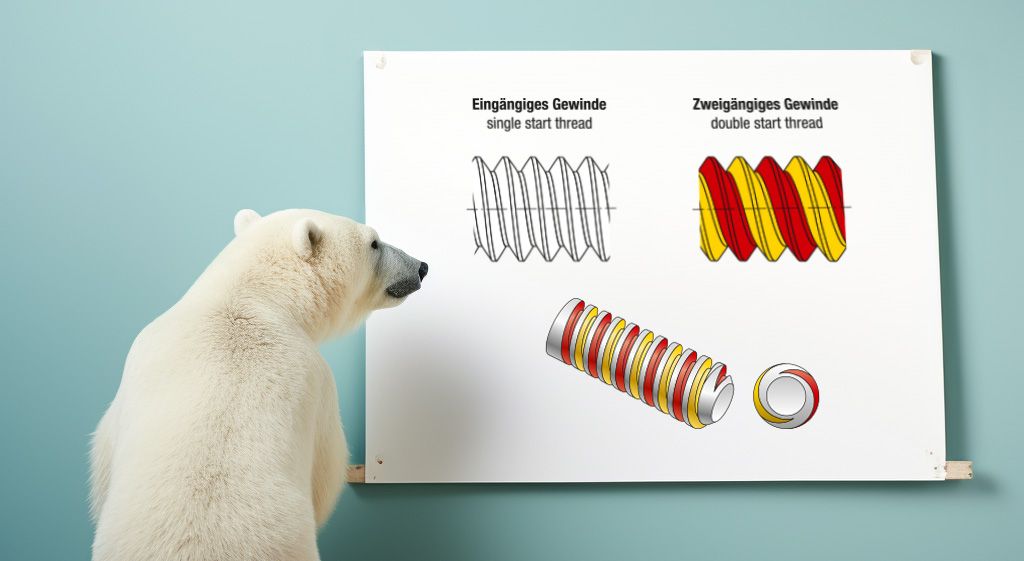
Multi-start thread unlike other threads
Threads can be quite confusing given the myriad types, standards, dimensions, rotation directions, and application areas. However, being well-informed is half the battle! And often, a grasp of the basics suffices to understand which thread is intended for which use. We aim to assist you in navigating this thread maze, and we continually delve into various thread types. Today's topic: multi-start threads. If you're wondering what single-start threads or multi-start threads are, you've come to the right place!
What is a thread start in single-start, double-start, or multi-start threads?
Brace yourselves; we're about to get technical. But don't be afraid, we'll start with the basics. Where there are multi-start threads, there must be single-start threads, right? Precisely! Single-start threads are the standard ones that you deal with daily. The term "single-start" refers to the number of thread starts.
A thread start is the groove that spirals around the bolt, essentially defining the thread. This groove is bounded by the thread flanks – much like the steep sides of a mountain. The thread pitch is determined by the distance between two thread crests. Depending on the thread type, these crests might be more or less pronounced. For example, trapezoidal threads have more of a plateau. In this case, the thread flanks are extended to the point where they would intersect.
For a single-start metric ISO thread, the pitch corresponds to the lead, i.e., the distance a nut would move along this thread in one complete turn. Moreover, most single-start threads have good self-locking properties. This means they won't loosen on their own, thanks to the friction and resistance they offer – a crucial characteristic, as screws are expected to remain firmly in place.
Double-start and multi-start threads
The relationship between pitch and lead in double-start or multi-start threads is a tad different, which we'll get to shortly. First things first: multi-start threads have more than one thread start winding around the bolt. To visualize, examine the end of a screw. A single-start thread will show one end of a thread start, whereas a double-start thread will display two. Another way to visualize: with a single-start thread, if you lay a string in the groove and wrap it around the bolt following the groove, the entire screw will be covered. With multi-start threads, you'll observe a consistent, spiral gap.
Note that the pitch remains unchanged. A thread with a 6 mm pitch remains so, even as a multi-start thread. It just possesses multiple starts. The distance between adjacent thread crests from different starts is termed the Pitch. This is included in the thread designation, e.g., M 16 x 6 P 2.
This relationship can be captured in a formula:
Number of Starts = Total Pitch / Single Pitch.
Using our earlier example: The number of starts would be 6 / 2 = 3. It's a triple-start thread with a 6 mm pitch and a thread flank distance of 2 mm.
And what about the lead? The lead increases according to the number of starts. So, with a double-start thread, twice the distance is covered in one revolution compared to a single-start thread.
How multi-start threads operate
Despite the theoretical intricacies, the practical application is straightforward. Tightening a screw with a single-start thread takes twice as long as with a double-start thread. With a multi-start thread, a greater distance is covered in one rotation. Simultaneously, the number of starts affects the self-locking property of the thread. Multi-start threads often have only residual or no self-locking property. A nut placed on such a thread would slide down the bolt without any external force.
It's worth noting that the number of thread starts cannot be increased indefinitely. The pitch remains constant, thus limiting the available space for thread starts. Hence, many starts are typically found in steep threads, which have a large pitch relative to their diameter, providing ample space.
Applications of multi-start threads
Multi-start threads are typically power screws. Unlike fastener threads, whose primary purpose is to firmly connect components, power screws facilitate force transmission. They aren't static but move along a bolt. Naturally, the capacity of multi-start threads to cover more distance in one rotation is advantageous here. Common power screws include the trapezoidal thread and the buttress thread. Think of the spindle in a machine tool. Another benefit of multi-start threads is their reduced friction, which mitigates wear and tear. This is crucial for power screws, which are in constant use compared to fastener threads.
Multi-start threads are seldom used as fastener threads. One exception is quick-action screws used, for example, in drywall installation. The increased speed must be weighed against the reduced self-locking property.
Lastly, a practical example. The twist caps, familiar from the kitchen and supermarket, employ multi-start threads! These not only allow you to open a jam jar with a single twist but their multiple "entry points" also make resealing easier.
Compared to single-start threads, multi-start threads are special. For crafting these custom-made items, it's always best to rely on experienced professionals. Ideally, you should turn to us as screw tap manufacturers! BAER's customer service is always available to answer questions about multi-start threads and other products or to collaborate with you in finding the best solution for your project. We look forward to assisting you!
